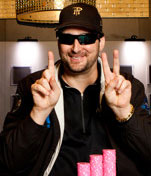-
Pocket Aces Are No Guarantee
On June 3, with a record field, the 2005 WSOP (World Series of Poker) got under way at the Rio Hotel in Las Vegas. The first event, a $1,500 buy-in no-limit Hold’em tournament, opened with 2,305 players! First place was roughly $700,000, and 200 players would make the money. I’m proud to say that I was one of those who made the money, which was my record-tying 46th “cash” (qualifying for prize money) at the WSOP. In fact, with about 60 players left I was the chip leader, but I faded down the stretch and finished a disappointing 24th.
Allow me to discuss the sickening hand I witnessed during the second day of the first tournament. With 236 players left (200 would make the money), a $100 ante and $400-$800 blinds, Jason Steinhorn opened in first position with 10-10. In the second position Ralph Levine made it $10,000 to go with his A-A. And now Greg Smallowitz, in third position, made a great fold with his J-J.
As if having A-A, J-J, and 10-10 out there in a single hand wasn’t enough, I held 7-7 in the fourth position and folded. Now Jim Lester picked up K-K in the sixth position and moved all-in with it for $21,600. Emad Alabsi picked up the other pair of tens in seventh position and eventually folded his hand. It came down to Jeff Shulman in the big blind (final position), he showed me his K-Q after he folded because I announced that I was going to write a column about this hand. And we still hadn’t got to the flop.
Now Steinhorn made the easy decision of folding his 10-10, and Levine called all of his remaining chips with his A-A, which is the best possible hand before the flop in Texas Hold’em. Knowing that Shulman had folded K-Q, I then announced that Lester had only one king left in the deck to draw to. Normally, a bigger pair is a 4 1/2-1 favorite over the smaller pair, but in this case, with three kings already gone, the aces were more like a 10-1 favorite over the kings.
After a flop of 6-6-4, the turn card was the “case” king (the fourth card of a particular rank), giving Jim Lester the winning hand! Ralph needed an ace on the river for a measure of justice, but, alas, it was not to be for him. The river card was a harmless seven (which would have made me a full house!). Everyone in this hand played well. J-J, 10-10, 10-10, 7-7, and K-Q all hit the muck, and A-A and K-K both put all of their money in pre-flop. Tough luck for Ralph, but that’s poker!WSOP HIGHLIGHTS
— I participated in the $1,500 buy-in limit Hold’em, which fielded more than 1,100 players. Again, I had the chip lead late in the event and faded, finishing 44th, but I did manage to break the all-time “cashes” record with 47. (To follow all of this record-breaking madness live, go to CardPlayer.com for up-to-the-minute “blogs” every day until July 15th.)
— One of the themes so far at the 2005 WSOP is that the pros are winning most of the tournaments, despite the enormous fields. In fact, the first event came down to four top pros, with Scott Fishman finishing second and Alan Cunningham winning it. Eric Seidel won his seventh WSOP bracelet, and T. J. Cloutier won his sixth (and in the process passed me for No. 2 on the all-time money list — his $3.7 million to my $3.6 million — with reigning world champion Greg Raymer holding the lead at $5 million).
— The $10,000 buy-in main event, which is the most prestigious tournament in poker, will get under way on July 7. Believe it or not, more than 5,000 people have already signed up, and the tournament managers are expecting a truly phenomenal field — somewhere between 6,600 and 10,000 players!
When should you fold K-K before the flop?
a.) when someone else moves all-in
b.) quite often
c.) almost never
d.) your first hand of a tournamentAnswer: C
Related Posts
- ‘High’ Stakes Poker
- Going for the Big M in Monte Carlo
- Still Doing Monte Carlo in Style
- Doing Monte Carlo in Style
- Hot Streak Freezes With a Cooler
- Chan Goes Down in the TOC
- Tournament of Champions
- Nice Guy Flushes Hellmuth’s Victory
- No-Limit at Roddick’s House
- Leaving 14 Dimes in the Sand
Recent Posts
- WSOPE 2nd place finish
- Update from this years WSOP 2019
- Happy Holidays! Updated stock at Poker Brat, new book!
- Phil Hellmuth wins historic 15th World Championship!
- Final golden ticket winner coming soon
- Poker Brat – The Phil Hellmuth Jr. Autobiography
- Phil Hellmuth’s “Pokerbrat” – Coming soon to audio book!
- Poker Night in America – Sugar House Casino
- Sugar House w Matt Glantz
- Lost and found

 ™
™








